ScalaTutorial-zh_CN
- 格式:pdf
- 大小:334.00 KB
- 文档页数:22
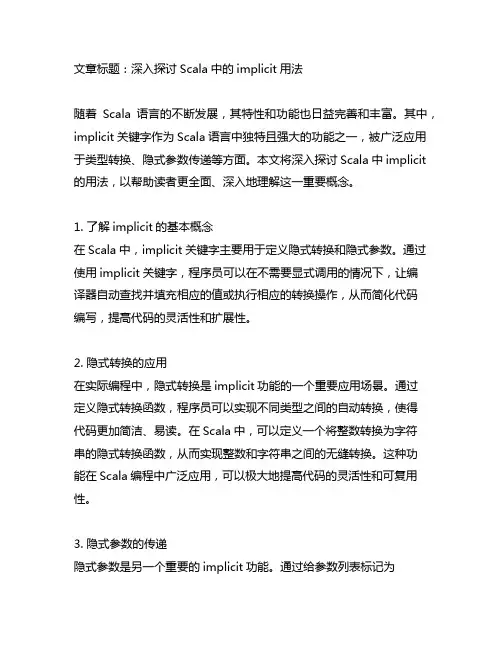
文章标题:深入探讨Scala中的implicit用法随着Scala语言的不断发展,其特性和功能也日益完善和丰富。
其中,implicit关键字作为Scala语言中独特且强大的功能之一,被广泛应用于类型转换、隐式参数传递等方面。
本文将深入探讨Scala中implicit 的用法,以帮助读者更全面、深入地理解这一重要概念。
1. 了解implicit的基本概念在Scala中,implicit关键字主要用于定义隐式转换和隐式参数。
通过使用implicit关键字,程序员可以在不需要显式调用的情况下,让编译器自动查找并填充相应的值或执行相应的转换操作,从而简化代码编写,提高代码的灵活性和扩展性。
2. 隐式转换的应用在实际编程中,隐式转换是implicit功能的一个重要应用场景。
通过定义隐式转换函数,程序员可以实现不同类型之间的自动转换,使得代码更加简洁、易读。
在Scala中,可以定义一个将整数转换为字符串的隐式转换函数,从而实现整数和字符串之间的无缝转换。
这种功能在Scala编程中广泛应用,可以极大地提高代码的灵活性和可复用性。
3. 隐式参数的传递隐式参数是另一个重要的implicit功能。
通过给参数列表标记为implicit,可以在调用函数时不显式传入对应的参数,在需要时由编译器自动查找并填充相应的值。
这种机制在一些复杂的场景下十分有用,能够简化代码的编写,提高代码的易用性和扩展性。
4. implicit的应用注意事项虽然implicit功能非常强大,但在使用时也需要注意一些细节问题。
过度使用implicit可能会导致代码变得晦涩难懂,降低代码的可读性。
隐式转换可能会在不经意间产生一些意想不到的行为,给代码的调试和维护带来困难。
在使用implicit时,需要谨慎考虑,避免滥用该功能,以保证代码的清晰和可维护性。
5. 个人观点与总结作为一种强大而灵活的功能,implicit在Scala中扮演着重要的角色,极大地丰富了编程的方式和技巧。
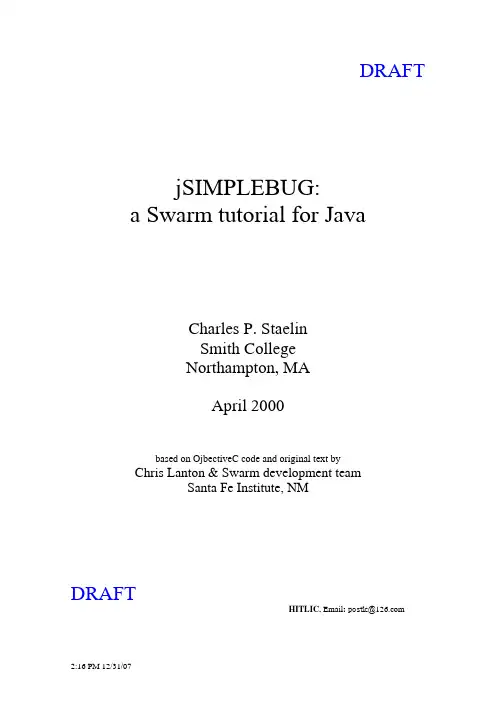

Solr tutorialTable of contents1 Overview (2)2 Requirements (2)3 Getting Started (2)4 Indexing Data (3)5 Updating Data (4)5.1 Deleting Data (5)6 Querying Data (5)6.1 Sorting (6)7 Highlighting (6)8 Faceted Search (7)9 Search UI (7)10 Text Analysis (7)10.1 Analysis Debugging (8)11 Conclusion (9)Copyright © 2007 The Apache Software Foundation. All rights reserved.1 OverviewThis document covers the basics of running Solr using an example schema, and some sample data.2 Requirements3 Getting StartedPlease run the browser showing this tutorial and the Solr server on the same machine so tutorial links will correctly point to your Solr server.Begin by unziping the Solr release and changing your working directory to be the "example" directory. (Note that the base directory name may vary with the version of Solr downloaded.) For example, with a shell in UNIX, Cygwin, or MacOS:user:~solr$ lssolr-nightly.zipuser:~solr$ unzip -q solr-nightly.zipuser:~solr$ cd solr-nightly/example/Solr can run in any Java Servlet Container of your choice, but to simplify this tutorial, the example index includes a small installation of Jetty.To launch Jetty with the Solr WAR, and the example configs, just run the start.jar ... user:~/solr/example$ java -jar start.jar2009-10-23 16:42:53.816::INFO: Logging to STDERR via org.mortbay.log.StdErrLog2009-10-23 16:42:53.907::INFO: jetty-6.1.26...Oct 23, 2009 4:41:56 PM org.apache.solr.core.SolrCore registerSearcherINFO: [] Registered new searcher Searcher@7c3885 mainThis will start up the Jetty application server on port 8983, and use your terminal to display the logging information from Solr.Copyright © 2007 The Apache Software Foundation. All rights reserved.Page 24 Indexing DataCopyright © 2007 The Apache Software Foundation. All rights reserved.Page 35 Updating DataCopyright © 2007 The Apache Software Foundation. All rights reserved.Page 4Page 5Copyright © 2007 The Apache Software Foundation. All rights reserved.6 Querying DataPage 6Copyright © 2007 The Apache Software Foundation. All rights reserved.7 Highlighting8 Faceted Search9 Search UI10 Text AnalysisText fields are typically indexed by breaking the text into words and applying various transformations such as lowercasing, removing plurals, or stemming to increase relevancy. The same text transformations are normally applied to any queries in order to match what is indexed.Copyright © 2007 The Apache Software Foundation. All rights reserved.Page 7Page 8Copyright © 2007 The Apache Software Foundation. All rights reserved.11 ConclusionCopyright © 2007 The Apache Software Foundation. All rights reserved.Page 9。
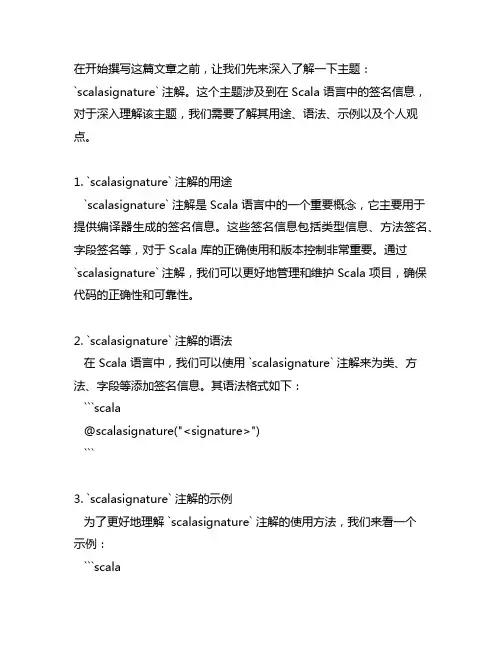
在开始撰写这篇文章之前,让我们先来深入了解一下主题:`scalasignature` 注解。
这个主题涉及到在 Scala 语言中的签名信息,对于深入理解该主题,我们需要了解其用途、语法、示例以及个人观点。
1. `scalasignature` 注解的用途`scalasignature` 注解是 Scala 语言中的一个重要概念,它主要用于提供编译器生成的签名信息。
这些签名信息包括类型信息、方法签名、字段签名等,对于 Scala 库的正确使用和版本控制非常重要。
通过`scalasignature` 注解,我们可以更好地管理和维护 Scala 项目,确保代码的正确性和可靠性。
2. `scalasignature` 注解的语法在 Scala 语言中,我们可以使用 `scalasignature` 注解来为类、方法、字段等添加签名信息。
其语法格式如下:```scala@scalasignature("<signature>")```3. `scalasignature` 注解的示例为了更好地理解 `scalasignature` 注解的使用方法,我们来看一个示例:```scalaclass MyClass {@scalasignature("ABCD1234")def myMethod(param: String): Int = { ... }}```在这个示例中,我们给 `myMethod` 方法添加了 `scalasignature`注解,其签名信息为 "ABCD1234"。
4. 个人观点和理解个人觉得,`scalasignature` 注解在 Scala 项目中起着非常重要的作用,它可以帮助开发人员更好地管理和维护代码库。
通过正确地使用`scalasignature` 注解,我们可以确保代码的正确性,并且在不同版本之间进行兼容性检查。
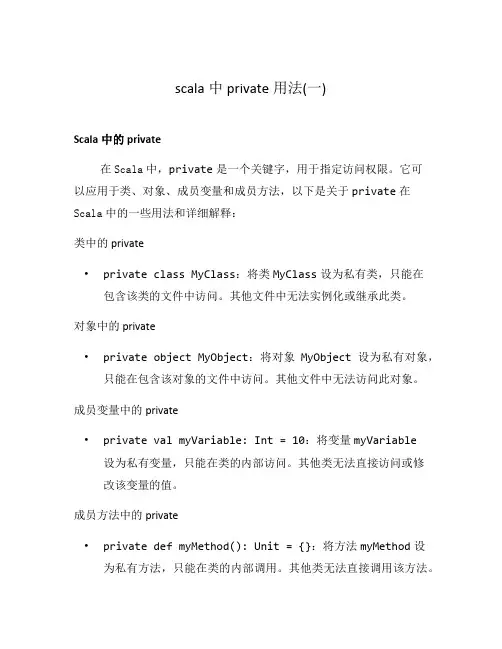
scala中private用法(一)Scala中的private在Scala中,private是一个关键字,用于指定访问权限。
它可以应用于类、对象、成员变量和成员方法,以下是关于private在Scala中的一些用法和详细解释:类中的private•private class MyClass:将类MyClass设为私有类,只能在包含该类的文件中访问。
其他文件中无法实例化或继承此类。
对象中的private•private object MyObject:将对象MyObject设为私有对象,只能在包含该对象的文件中访问。
其他文件中无法访问此对象。
成员变量中的private•private val myVariable: Int = 10:将变量myVariable 设为私有变量,只能在类的内部访问。
其他类无法直接访问或修改该变量的值。
成员方法中的private•private def myMethod(): Unit = {}:将方法myMethod设为私有方法,只能在类的内部调用。
其他类无法直接调用该方法。
伴生对象中的private•class MyClass:定义一个类MyClass–private object MyObject:在MyClass的伴生对象中定义私有对象MyObject,只能在MyClass中访问。
包中的private•package:在指定的包``中定义私有成员。
–private[example] val myVariable: Int = 10:将变量myVariable设为``包可见,其他包无法访问。
父类中的private•class Parent { private valparentVariable: Int = 10 }:在父类Parent中定义私有变量parentVariable,只能在父类中访问。
•class Child extends Parent { def accessParentVariable(): Int ={ println(parentVariable) // 编译错误,无法访问父类中的私有变量 } }:在子类Child中无法直接访问父类Parent中的私有变量parentVariable,会导致编译错误。
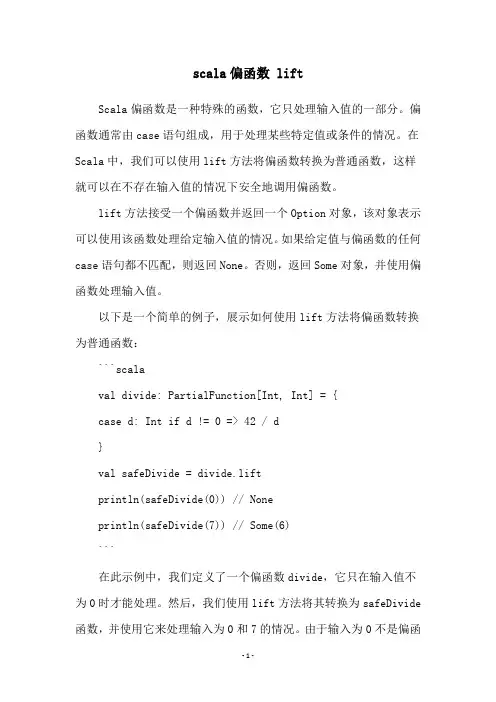
scala偏函数 liftScala偏函数是一种特殊的函数,它只处理输入值的一部分。
偏函数通常由case语句组成,用于处理某些特定值或条件的情况。
在Scala中,我们可以使用lift方法将偏函数转换为普通函数,这样就可以在不存在输入值的情况下安全地调用偏函数。
lift方法接受一个偏函数并返回一个Option对象,该对象表示可以使用该函数处理给定输入值的情况。
如果给定值与偏函数的任何case语句都不匹配,则返回None。
否则,返回Some对象,并使用偏函数处理输入值。
以下是一个简单的例子,展示如何使用lift方法将偏函数转换为普通函数:```scalaval divide: PartialFunction[Int, Int] = {case d: Int if d != 0 => 42 / d}val safeDivide = divide.liftprintln(safeDivide(0)) // Noneprintln(safeDivide(7)) // Some(6)```在此示例中,我们定义了一个偏函数divide,它只在输入值不为0时才能处理。
然后,我们使用lift方法将其转换为safeDivide 函数,并使用它来处理输入为0和7的情况。
由于输入为0不是偏函数能够处理的情况之一,因此调用safeDivide(0)将返回None。
另一方面,调用safeDivide(7)将返回Some(6),表示该函数将输入7处理为6。
总之,Scala的偏函数提供了一种非常方便的方式来处理特定的值或条件。
使用lift方法,可以将偏函数转换为普通函数,并使其安全地处理不匹配的输入情况。
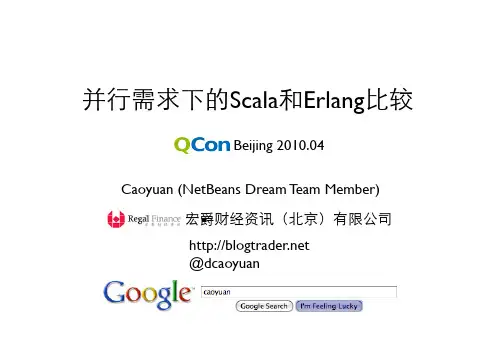
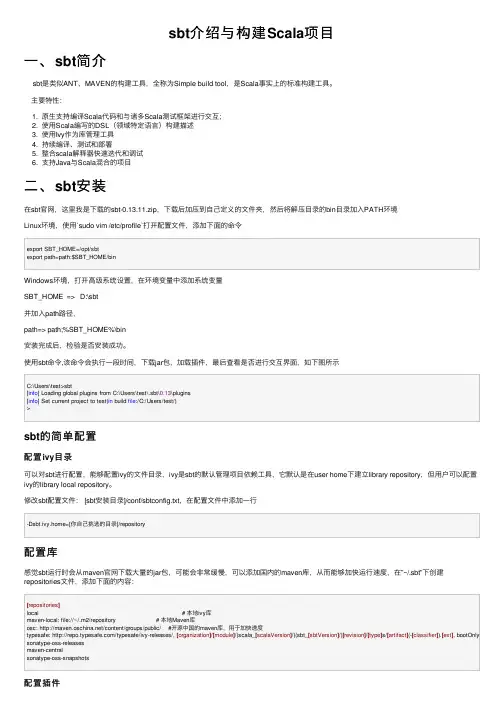
sbt介绍与构建Scala项⽬⼀、sbt简介sbt是类似ANT、MAVEN的构建⼯具,全称为Simple build tool,是Scala事实上的标准构建⼯具。
主要特性:1. 原⽣⽀持编译Scala代码和与诸多Scala测试框架进⾏交互;2. 使⽤Scala编写的DSL(领域特定语⾔)构建描述3. 使⽤Ivy作为库管理⼯具4. 持续编译、测试和部署5. 整合scala解释器快速迭代和调试6. ⽀持Java与Scala混合的项⽬⼆、sbt安装在sbt官⽹,这⾥我是下载的sbt-0.13.11.zip,下载后加压到⾃⼰定义的⽂件夹,然后将解压⽬录的bin⽬录加⼊PATH环境Linux环境,使⽤`sudo vim /etc/profile`打开配置⽂件,添加下⾯的命令export SBT_HOME=/opt/sbtexport path=path:$SBT_HOME/binWindows环境,打开⾼级系统设置,在环境变量中添加系统变量SBT_HOME => D:\sbt并加⼊path路径,path=> path;%SBT_HOME%\bin安装完成后,检验是否安装成功。
使⽤sbt命令,该命令会执⾏⼀段时间,下载jar包,加载插件,最后查看是否进⾏交互界⾯,如下图所⽰C:\Users\test>sbt[info] Loading global plugins from C:\Users\test\.sbt\0.13\plugins[info] Set current project to test(in build file:/C:/Users/test/)>sbt的简单配置配置ivy⽬录可以对sbt进⾏配置,能够配置ivy的⽂件⽬录,ivy是sbt的默认管理项⽬依赖⼯具,它默认是在user home下建⽴library repository,但⽤户可以配置ivy的library local repository。
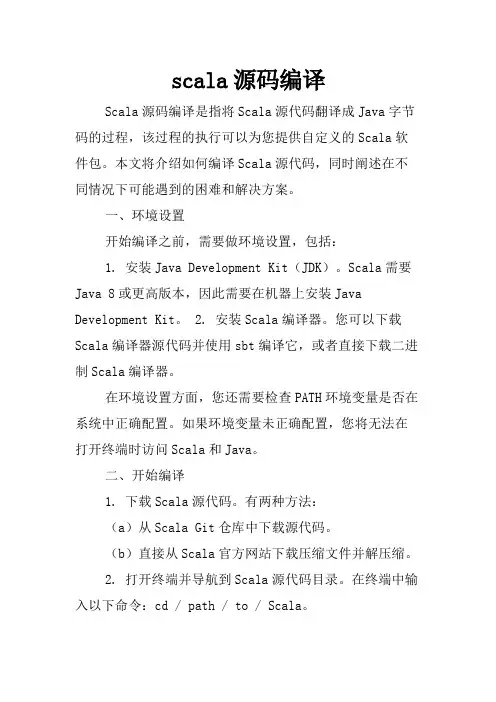
scala源码编译Scala源码编译是指将Scala源代码翻译成Java字节码的过程,该过程的执行可以为您提供自定义的Scala软件包。
本文将介绍如何编译Scala源代码,同时阐述在不同情况下可能遇到的困难和解决方案。
一、环境设置开始编译之前,需要做环境设置,包括:1. 安装Java Development Kit(JDK)。
Scala需要Java 8或更高版本,因此需要在机器上安装Java Development Kit。
2. 安装Scala编译器。
您可以下载Scala编译器源代码并使用sbt编译它,或者直接下载二进制Scala编译器。
在环境设置方面,您还需要检查PATH环境变量是否在系统中正确配置。
如果环境变量未正确配置,您将无法在打开终端时访问Scala和Java。
二、开始编译1. 下载Scala源代码。
有两种方法:(a)从Scala Git仓库中下载源代码。
(b)直接从Scala官方网站下载压缩文件并解压缩。
2. 打开终端并导航到Scala源代码目录。
在终端中输入以下命令:cd / path / to / Scala。
3. 编译Scala源代码。
接下来,可以使用sbt进行完Scala源代码的编译。
(a)sbt是什么?sbt是Scala Build Tool的缩写。
使用sbt可以使源代码构建过程更容易,sbt不仅支持Scala,还可以用于构建Java项目。
sbt常用于自动化构建Scala应用程序。
(b)使用sbt目录结构:在Scala源码的根目录下,有一个构建文件build.sbt。
该文件包含有关构建过程的信息,例如源文件的位置和编译选项。
首先要确定当前目录是否包含build.sbt文件。
如果没有,需要在源代码根目录下建立该文件。
由于文件不包含任何内容,因此可以直接编写代码。
编写完构建文件后,再执行命令:sbt compile。
这将启动编译过程,编译结果将生成到target / classes子目录中。
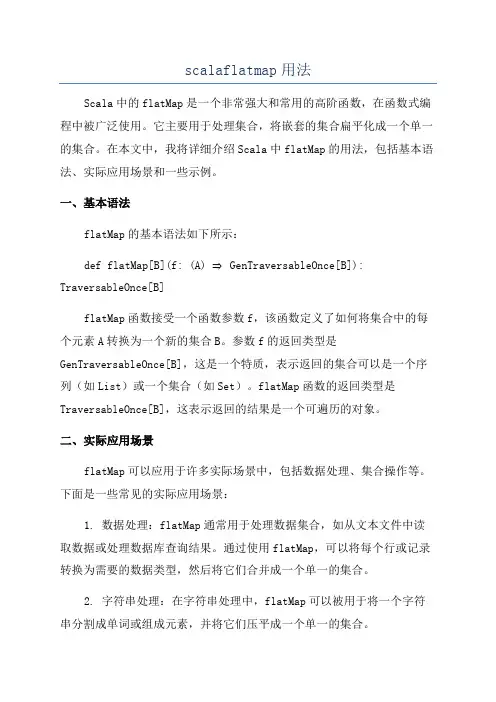
scalaflatmap用法Scala中的flatMap是一个非常强大和常用的高阶函数,在函数式编程中被广泛使用。
它主要用于处理集合,将嵌套的集合扁平化成一个单一的集合。
在本文中,我将详细介绍Scala中flatMap的用法,包括基本语法、实际应用场景和一些示例。
一、基本语法flatMap的基本语法如下所示:def flatMap[B](f: (A) ⇒ GenTraversableOnce[B]): TraversableOnce[B]flatMap函数接受一个函数参数f,该函数定义了如何将集合中的每个元素A转换为一个新的集合B。
参数f的返回类型是GenTraversableOnce[B],这是一个特质,表示返回的集合可以是一个序列(如List)或一个集合(如Set)。
flatMap函数的返回类型是TraversableOnce[B],这表示返回的结果是一个可遍历的对象。
二、实际应用场景flatMap可以应用于许多实际场景中,包括数据处理、集合操作等。
下面是一些常见的实际应用场景:1. 数据处理:flatMap通常用于处理数据集合,如从文本文件中读取数据或处理数据库查询结果。
通过使用flatMap,可以将每个行或记录转换为需要的数据类型,然后将它们合并成一个单一的集合。
2. 字符串处理:在字符串处理中,flatMap可以被用于将一个字符串分割成单词或组成元素,并将它们压平成一个单一的集合。
3. 集合操作:flatMap可以用于对集合进行操作,如过滤、排序、映射和连接等。
通过使用flatMap,可以将一系列操作链接在一起,以便在单次迭代中完成多个操作。
4. 并行处理:当处理大数据集时,flatMap可以与并行处理结合使用,以提高处理性能。
通过使用flatMap,可以将数据分解为小块,并在多个处理器上并行处理这些块。
三、示例下面是一些使用flatMap的示例代码,用于说明其在实际编程中的用法:1.处理文本文件中的数据:```scalaval lines =scala.io.Source.fromFile("data.txt").getLines.toListval words = lines.flatMap(_.split(" "))```上面的代码从文本文件中读取每一行,并通过flatMap将每行分割成单词。
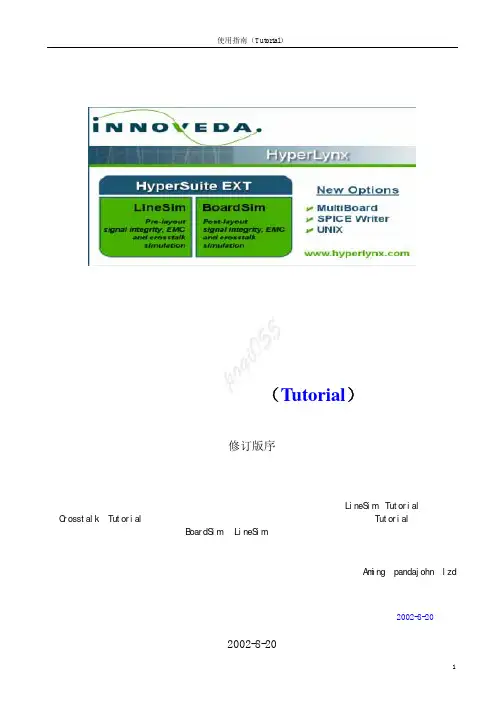
使用指南(Tutorial)修订版序从首次接触这个软件到现在,有一段时间了。
那时由于急着使用,因此对一些认为不太重要的地方没有进行整理。
后来才发现,其实每一部分都是很有用的。
此修订,一个是将LineSim(Tutorial)与后加的Crosstalk(Tutorial)的目录统一起来,再有就是原文基础上增加了多板仿真(Tutorial)一节。
同样,对于那一时期我整理的BoardSim 、LineSim使用手册,也有同样的一个没有对一些章节进行翻译整理问题(当初认为不太重要)。
而实际上使用时,有一些东西是非常重要的,同时也顺便进行了翻译。
此外,通过使用,对该软件有了更多一些理解,显然以前只从字面翻译的东西不太好理解,等我有时间将它们重新整理后,再提供给初学的朋友。
对在学习中给予我大量无私帮助的Aming、pandajohn、lzd 等网友表示忠心的感谢。
P o q i0552002-8-202002-8-20目录使用指南(TUTORIAL ) 1 第一章 LINESIM4 1.1 在L INE S IM 里时钟信号仿真的教学演示 4 第二章 时钟网络的EMC 分析 7 2.1 对是中网络进行EMC 分析7 第三章 LINESIM'S 的干扰、差分信号以及强制约束特性 8 3.1 “受害者”和 “入侵者” 8 3.2如何定线间耦合。
8 3.3 运行仿真观察交出干扰现象9 3.4 增加线间距离减少交叉干扰(从8 MILS 到 12 MILS ) 93.5 减少绝缘层介电常数减少交叉干扰 93.6 使用差分线的例子(关于差分阻抗) 93.7仿真差分线 10第四章 BOARDSIM114.1 快速分析整板的信号完整性和EMC 问题 11 4.2 检查报告文件 11 4.3 对于时钟网络详细的仿真 11 4.4 运行详细仿真步骤: 11 4.5 时钟网络CLK 的完整性仿真 12 第五章 关于集成电路的MODELS 145.1 模型M ODELS 以及如何利用T ERMINATOR W IZARD 自动创建终接负载的方法 14 5.2 修改U3的模型设置(在EASY.MOD 库里CMOS,5V,FAST ) 14 5.3 选择模型(管脚道管脚)C HOOSING M ODELS I NTERACTIVELY (交互), P IN -BY -P IN 14 5.4 搜寻模型(F INDING M ODELS (THE "M ODEL F INDER "S PREADSHEET ) 15 5.5 例子:一个没有终接的网络 15 第六章 BOARDSIM 的干扰仿真 186.1 B OARD S IM 干扰仿真如何工作 186.3仿真的例子:在一个时钟网络上预测干扰 18 6.3.1加载本例的例题“DEMO2.HYP” 18 6.3.2A UTOMATICALLY F INDING "A GGRESSOR"N ETS 18 6.3.3为仿真设置IC模型 19 6.3.4查看在耦合区域里干扰实在什么地方产生的 19 6.3.5驱动IC压摆率影响干扰和攻击网络 20 6.3.6电气门限对比几何门限 20 6.3.7用交互式仿真"CLK2"网络 20 6.4快速仿真:对整个PCB板作出干扰强度报告 20 6.5运行详细的批模式干扰仿真 21第七章关于多板仿真237.1多板仿真例题,检查交叉在两块板子上网络的信号质量 23 7.2浏览在多板向导中查看建立多板项目的方法 24 7.3仿真一个网络A024 7.4用EBD模型仿真24HyperLynxHyperLynx是高速仿真工具,包括信号完整性(signal-integrity)、交叉干扰(crosstalk)、电磁屏蔽仿真(EMC)。
感 谢本tutorial Manual 2.2翻译文档在许多网友的关心和支持下,得以翻译成功,在此对他们表示热烈地感谢:蝈蝈、fiona、kailinziv、Yan、杀毒软件、tiny0o0、timothy、prolee等关心TG手册翻译的热心朋友。
关于本文档内容说明:由于本手册由不同网友翻译,可能对某些概念有不同的理解,翻译可能不大一样,但决不影响理解,欢迎大家探讨。
再一次对各位网友的努力和汗水表示感谢!如有什么问题可以联系我:Mail:tiny0o0@注:本文档内容版权归X Y Z scientific company 所有,谢绝任何意图商用。
I、TrueGrid介绍True Grid是一套优秀的、功能强大的通用网格生成前处理软件。
它可以方便快速生成优化的、高质量的、多块结构的六面体网格模型。
作为一套简单易用,交互式、批处理前处理器,True Grid支持三十多款当今主流的分析软件。
True Grid是基于多块体结构(multiple-block-structured)的网格划分工具,尽管这个指南手册开始会提供一些介绍信息,新手还是强烈要求阅读用户手册(True Grid® User’s Manual)的前2章,用户指南和参考手册。
True Grid是几何和网格形成过程是分开进行。
曲面和曲线形成的方式有以下几种:内部产生,从CAD/CAE系统导出IGES格式导入TG,或用vpsd命令导入多边曲面。
块网格(block mesh)初始化然后通过各种变换与几何模型匹配形成最后的有限元模型。
True Grid网格划分过程:运用block命令初始化块网格;块网格部分会被删掉以使拓扑结构与划分目标对应;块网格部分通过移动,曲线定位,曲面投影等方法进行变换;网格插值、光滑和Zoning(控制边界节点分布)等技术可以用来形成更好的网格;块网格之间独立形成,然后通过块边界面(BB)和普通节点合并命令(指定容差范围内合并)将各块网格合并成完整的有限元模型。
Maven是一个软件项目管理和理解工具,可以帮助开发者管理项目的构建、依赖关系和文档。
在实际的软件开发过程中,很多项目可能同时使用Scala和Java进行编码,因此需要将这两种编程语言混合在一起进行开发。
本文将探讨Maven中如何进行Scala和Java项目的混合编码。
一、Maven基本概念1. Maven的作用Maven是一个开源的项目管理工具,可以帮助开发人员管理项目的构建、依赖关系和文档等。
通过Maven,开发者可以更加方便地管理项目的各种资源,确保项目的稳定和可靠性。
2. Maven的组成Maven由一组插件和项目对象模型(Project Object Model,POM)组成。
POM是Maven项目的核心,它包含了项目的信息、依赖关系和构建配置等。
插件则可以扩展Maven的功能,例如用于编译、测试和打包等。
二、Scala和Java项目混合编码1. Scala和Java的关系Scala是一种多范式的编程语言,它兼容Java,并且可以与Java代码无缝集成。
在实际项目开发中,很多项目会同时使用Scala和Java进行编码。
2. Maven支持Scala项目Maven通过Scala插件可以很好地支持Scala项目的构建和管理。
开发者可以使用Scala插件来编译Scala代码、打包Scala应用程序和管理Scala项目的依赖关系。
3. Maven支持Java项目作为Java项目管理的利器,Maven在管理Java项目方面也表现出色。
开发者可以使用Maven来构建和管理Java项目,包括编译Java代码、打包Java应用程序和管理Java项目的依赖关系。
4. Scala和Java项目的混合编码当项目同时使用Scala和Java进行编码时,开发者需要将两种语言的代码整合在一起,并且确保项目的依赖关系能够正确管理。
在使用Maven进行混合编码时,需要考虑以下几个方面:- 项目结构:需要合理组织项目的目录结构,例如将Scala和Java代码分别放在不同的目录中。
IDEA写scala简单操作今天尝试了⼀下在IntelliJ IDEA⾥⾯写Scala代码,并且做到和Java代码相互调⽤,折腾了⼀下把过程记录下来。
⾸先需要给IntelliJ IDEA安装⼀下Scala的插件,在IDEA的启动界⾯点击 Configure -> Plugins,然后搜索Scala,点击 Install 即可,安装完插件以后,就可以创建Scala Project和Scala Class等。
创建⼀个Maven⼯程,最简单的那种:maven-archetype-quickstart(mvn archetype:generate -DgroupId=com.scala -DartifactId=simple -DarchetypeArtifactId=maven-archetype-quickstart -DinteractiveMode=false)打开这个项⽬,然后在项⽬⾥⾯创建⼀个scala-sdk:Project Structure -> Global Libraries -> + Scala SDK,然后选择上⾯下载解压出来的scala⽬录。
maven⼯程的java代码⼀般是这么放的:src/main/java/com.xxx.xxx⽽我们的Scala的代码可以这么放:src/main/scala/com.xxx.xxx并把这个⽬录设置为Sources Root(在IDEA⾥⾯右击scala⽂件夹,然后点击 Make Directory As -> Sources Root)POM.xml⾥⾯加⼊scala相关的dependency和plugin<dependency><groupId>org.scala-lang</groupId><artifactId>scala-library</artifactId><version>2.12.1</version></dependency><dependency><groupId>org.scala-lang</groupId><artifactId>scala-compiler</artifactId><version>2.12.1</version></dependency><dependency><groupId>org.scala-lang</groupId><artifactId>scala-reflect</artifactId><version>2.12.1</version></dependency><dependency><groupId>org.scala-lang</groupId><artifactId>scala-actors</artifactId><version>2.11.8</version></dependency><dependency><groupId>org.scala-tools</groupId><artifactId>maven-scala-plugin</artifactId><version>2.15.2</version></dependency><plugin><!-- 这是个编译java代码的 --><groupId>org.apache.maven.plugins</groupId><artifactId>maven-compiler-plugin</artifactId><version>3.2</version><configuration><source>1.8</source><target>1.8</target><encoding>UTF-8</encoding></configuration><executions><execution><phase>compile</phase><goals><goal>compile</goal></goals></execution></executions></plugin><plugin><!-- 这是个编译scala代码的 --><groupId>net.alchim31.maven</groupId><artifactId>scala-maven-plugin</artifactId><version>3.2.1</version><executions><execution><id>scala-compile-first</id><phase>process-resources</phase><goals><goal>add-source</goal><goal>compile</goal></goals></execution></executions></plugin>在scala⽬录⾥⾯新建⼀个scala class:1 2 3 4 5class ScalaApp {def main(args:Array[String]) { println("hello scala")}}然后在Java⾥⾯的⼀个class⾥⾯调⽤:public static void main(String[] args) {System.out.println("Hello World!");ScalaApp scalaApp = new ScalaApp();scalaApp.main(args);}然后在IDEA⾥⾯compile⼀下,运⾏上⾯的main函数,可以发现java和scala的代码都运⾏了。
A Scala Tutorialfor Java programmersVersion1.3March15,2009Michel Schinz,PhilippHaller靳雄飞(中文翻译)P ROGRAMMING M ETHODS L ABORATORYEPFLS WITZERLAND1 介绍- Introduction本文档是Scala语言和编译器的快速入门介绍,适合已经有一定编程经验,且希望了解Scala可以做什么的读者。
我们假定本文的读者具有面向对象编程(Object-oriented programming,尤其是java相关)的基础知识。
This document gives a quick introduction to the Scala language and compiler. Itis intended for people who already have some programming experience and wantan overview of what they can do with Scala. A basic knowledge of object-oriented programming, especially in Java, is assumed.2 第一个例子-A first example我们使用最经典的“Hello world”作为第一个例子,这个例子虽然并不是特别炫(fascinating),但它可以很好的展示Scala的用法,且无须涉及太多的语言特性。
示例代码如下:As a first example, we will use the standard Hello world program. It is not very fascinatingbut makes it easy to demonstrate the use of the Scala tools without knowing too much about the language. Here is how it looks:object HelloWorld { defmain(args: Array[String]){ println("Hello,world!") } }Java程序员应该对示例代码的结构感到很熟悉:它包含一个main方法,其参数是一个字符串数组,用来接收命令行参数;main的方法体只有一句话,调用预定义的println 方法输出“Hello world!”问候语。
main方法不返回值(这是一个过程方法procedure method),因此,该方法不必声明返回值类型。
The structure of this program should be familiar to Java programmers: it consists of one method called main which takes the command line arguments, an array of strings, as parameter; the body of this method consists of a single call to the predefined method println with the friendly greeting as argument. The main method does not return a value (it is a procedure method). Therefore, it is not necessary to declare a return type.对于包含main方法的object声明,Java程序员可能要相对陌生一些。
这种声明方式引入了一个通常被称为单例对象(singleton object)的概念,也就是有且仅有一个实例的类。
因此,上例中的声明,在定义了一个名为的HelloWorld类的同时,还声明了该类的一个实例,实例的名字也叫HelloWorld。
该实例在第一次被用到的时候即时(on demand)创建。
What is less familiar to Java programmers is the object declaration containing the main method. Such a declaration introduces what is commonly known as a singleton object, that is a class with a single instance. The declaration above thus declares botha class called HelloWorld and an instance of that class, also called HelloWorld. This instance is created on demand, the first time it is used.细心(astute,机敏的,聪明的)的读者可能会注意到,main方法并没有声明为static。
这是因为Scala中不存在静态成员(无论方法还是属性,methods or fields)这一概念,Scala使用前述的单例对象(singleton objects)中的成员来代替静态成员。
The astute reader might have noticed that the main method is not declared as static here. This is because static members (methods or fields) do not exist in Scala. Rather than defining static members, the Scala programmer declares these members in singleton objects.2.1 编译该示例- Compiling the example要编译上面写的例子,要scalac命令,这就是Scala的编译器。
scalac的工作流程和多数编译器类似:从命令行上接收待编译的源文件名(source file)以及编译参数,生成一个或者多个目标文件(object files,或者叫对象文件)。
Scala生成的目标文件是标准的java class文件。
To compile the example, we use scalac, the Scala compiler. scalac works like most compilers: it takes a source file as argument, maybe some options, and produces one or several object files. The object files it produces are standard Java class files.假如我们将HelloWorld示例程序存放到HelloWorld.scala文件中,则可以用以下指令进行编译(大于号’>’表示shell/命令行的提示符,不需要人工键入):If we save the above program in a file called HelloWorld.scala, we can compile it by issuing the following command (the greater-than sign ‘>’ represents the shell prompt and should not be typed):> scalac HelloWorld.scala该指令执行后,会在当前目录下生成几个class文件,其中一个是HelloWorld.class,该文件中包含一个可以直接被scala指令执行的类(class),具体操作参见后续章节。
This will generate a few class files in the current directory. One of them will be called HelloWorld.class, and contains a class which can be directly executed using the scala command, as the following section shows.2.2 运行该示例-Running the example代码编译通过以后,可以使用scala指令运行程序,scala指令和java指令的用法非常相似,甚至它们接受的命令行参数都是一样的。
前面编译好的例子,可以用如下指令运行,并输出预期的问候语:Once compiled, a Scala program can be run using the scala command. Its usage is very similar to the java command used to run Java programs, and accepts the same options. The above example can be executed using the following command, which produces the expected output:> scala -classpath . HelloWorldHello, world!3 和Java进行交互- Interaction with Java和Java代码的交互能力,是Scala语言的强项之一。
在Scala程序中,ng包下的类是默认全部引入的,其它包下的类则需要显式(explicitly)引入。
One of Scala’s strengths is that it makes it very easy to interact with Java code. All classes from the ng package are imported by default, while others need to be imported explicitly.我们可以通过一个例子来展示Scala与Java的交互能力。
假如,我们想获取系统当前时间,并按照某个国家(比如法国)的显示习惯进行格式化1。